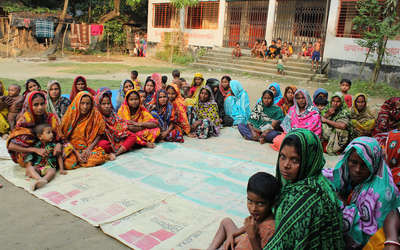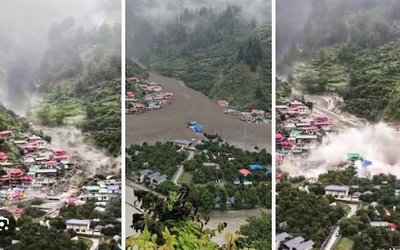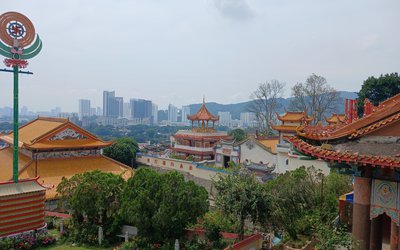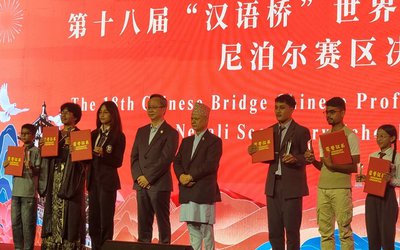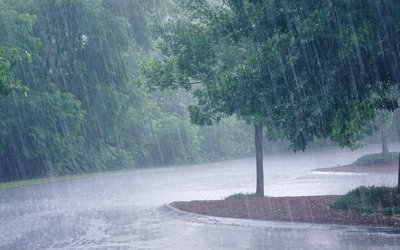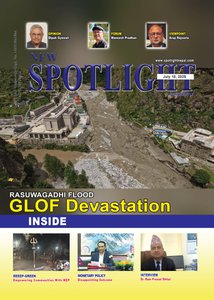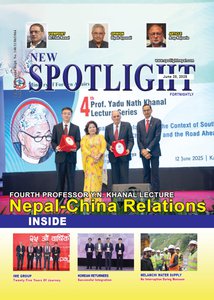The ongoing drought in Terai and the Churia range has garnered significant media attention, particularly following the Prime Minister's recent visit and proposal to construct deep wells to support water supply and safeguard farmers. While the construction of deep wells may address immediate water needs, it could have long-term ramifications for sustainable water management if not constructed in a right way along with design that includes water recharging wells—especially as more frequent droughts are anticipated due to global climate change. Without integrated recharge strategies, this solution risks becoming a classic case of “Fixes That Fail”, where short-term relief undermines long-term resilience. Although climate change, characterized by shifting precipitation patterns and increased evapotranspiration, is often cited as the primary driver of water scarcity, local and regional socio-ecological changes are equally critical and must not be overlooked.
Water systems are intricately interconnected extending from headwaters to downstream communities, vertically between surface and groundwater, and laterally across streams, floodplains, and wetlands. While surface water connections are visible and often easily understood, similar interactions occurring underground is complex and often overlooked. Groundwater in one region may originate as surface water in another, and vice versa. For example, rainfall becomes surface water as it flows through rivers, infiltrates into the ground to recharge aquifers, and may later re-emerge as baseflow or new streams.
These hydrological processes highlight the importance of cross-scale strategies and integrated management approaches. Changes in headwater regions can significantly affect downstream areas, and downstream interventions can influence upstream conditions. Water availability is shaped by a complex interplay of ecological and social systems, making a watershed-scale approach essential for effective management.
To address water scarcity meaningfully, it is crucial to understand the diverse drivers of change and the behaviors they influence. Only by recognizing these interdependencies can we develop sustainable solutions that respond to both immediate needs and long-term challenges.
Here we outline the local-scale and regional-scale challenges and discuss some of the strategies to overcome them.
Drivers of Declining Water Availability in Terai
Decline in Cultivated Land
Agricultural land in Madhesh is steadily shrinking due to urban expansion, a decline in youth interest in farming, and increased migration. According to Nepal’s National Agricultural Census (2021/22), cultivable land has declined by approximately 300,000 hectares over the past decade—from 2.5 million to 2.2 million hectares. Temporarily fallow land has nearly doubled, now exceeding 60,000 hectares. Urban growth along the East-West Highway has replaced traditional summer paddy fields and winter wheat farms with impervious surfaces, disrupting natural hydrological cycles.
Historically, practices such as flood irrigation and winter tillage not only supported crop production but also contributed to groundwater recharge. While these practices are well recognized in scientific literature, their role as part of a socio-ecological system that promotes recharge is rarely acknowledged—and now, they are rapidly fading.
In response to these changes, alternative approaches to groundwater recharge are gaining global attention. One such method is Agricultural Managed Aquifer Recharge (Ag-MAR), which involves intentionally flooding fallow, dormant, or active cropland with excess surface water. This technique has shown promise in enhancing both groundwater recharge and agricultural productivity. For example, a hydrological modeling study in Idaho, USA, found that Ag-MAR operations reduced springtime peak flows at the watershed outlet by 10%–14%, while increasing streamflow by 6%–14% during July–August and by 9%–14% from November to March.
Importantly, traditional knowledge in Nepal has long recognized the emergence of water springs downstream of agricultural lands as a sign of groundwater contribution. By integrating this indigenous understanding with global scientific practices, implementing Ag-MAR in Nepal could offer dual benefits: improving groundwater recharge and mitigating flash floods.
Soil Erosion and River Channel Incision
The Churia region’s loose, gravelly soils are highly vulnerable to erosion. Urban expansion and the decline of agricultural land and irrigation ditches have increased surface runoff, raising the volume and energy of river flows. At the same time, unregulated sediment extraction has deepened river channels, contributing to channel incision. As river channels become incised, they disconnect from their floodplains, accelerating water flow, reducing infiltration time, and lowering groundwater tables. A direct consequence of this process is the loss of baseflow during dry seasons.
Globally, many nature-based solutions have been implemented to reconnect rivers and streams with their lateral floodplain systems. These approaches have proven effective in restoring natural recharge functions and supporting local ecosystems. Applying similar strategies to stream and river management in Nepal could enhance water availability and resilience. By integrating ecological restoration with hydrological planning, we can mitigate erosion, improve groundwater recharge, and reduce the risk of flash floods.
Tree-Centric Environmentalism in Development Projects
While tree planting is emphasized in Nepal’s environmental policies, while executing large infrastructural projects such as hydropower, highways, airports etc.—such as the tree removal compensation ratio, revised from 1:25 to 1:10—the impacts on water systems are often overlooked. Infrastructure projects, particularly highways, frequently create impervious surfaces without incorporating recharge facilities. During my visit to Biratnagar in 2017, I witnessed severe flooding that submerged the airport and disrupted flights for over a week. Upon closer observation, I found that the conversion of traditional earthen ditches to concrete-lined roadside channels along the Dharan–Biratnagar Highway rapidly diverted water into rivers. This not only contributed to urban flooding but also reduced opportunities for groundwater recharge.
To mitigate such impacts, large infrastructure projects must include stormwater management designs with recharge basins as a form of environmental compensation. Countries like the United States have adopted such policies through legislation like the Clean Water Act (CWA), and states like California have integrated stormwater and groundwater management into housing and development projects.
Encouragingly, some municipalities in Nepal have begun constructing recharge ponds and mandating recharge pits, particularly in Dharan and Dhulikhel. However, these efforts need to be scaled up and systematized to ensure long-term water sustainability. By integrating recharge infrastructure into urban planning and development, Nepal can better manage stormwater, reduce flood risks, and enhance groundwater availability.
Over-Extraction of ground water in Nepal and Neighboring Indian States
Groundwater depletion is a growing concern not only in Nepal’s southern belt but also in neighboring Indian states like Bihar and Uttar Pradesh. Nepal and India share the Ganges Basin aquifer, a transboundary groundwater system with a significant footprint. A study by Naga Laveti (2021, Journal of Hydrology) reported that over 80% of agricultural land in Bihar depends on groundwater. The number of pumps used for extraction rose dramatically—from 0.37 million in 1976–77 to 1.56 million in 1997–98—with further increases in recent years. This surge has significantly reduced net recharge and increased annual extraction rates.
Groundwater, like surface water, flows from higher to lower elevations. Intensive farming and deep borewell extraction in Indian states have lowered their water tables, increased the hydraulic gradient, and accelerated groundwater flow out of Nepal. This results in a faster decline in Nepal’s groundwater levels and an increasing depth to the water table. Compounding the issue, changes in Nepal’s water systems have reduced natural recharge opportunities.
Groundwater pumping also disrupts surface-water systems by decreasing the natural hydraulic gradients that feed rivers and wetlands. It lowers the water table below the reach of plant roots, reducing evapotranspiration and affecting vegetation health.
The Urgent Need for Transboundary Groundwater Diplomacy
Nepal and India share the Ganga watershed—encompassing both surface and groundwater systems—recent research from the Indian side has revealed that dry season river flows are sustained primarily by groundwater contributions as baseflow, rather than by glacial melt. This underscores the importance of adopting a watershed-scale approach and recognizing the connectivity of hydrological systems in addressing water scarcity and ensuring sustainable water management across borders. In humid regions like South Asia, recharge occurs widely across aquifer surfaces through precipitation percolation. Therefore Nepal, as a headwater region, plays a vital role in regional groundwater recharge. Efforts to enhance recharge within Nepal directly benefit downstream Indian states. Conversely, over-extraction in India—particularly in Bihar and Uttar Pradesh—negatively impacts Nepal’s groundwater reserves by increasing hydraulic gradients and accelerating transboundary groundwater flow. These findings highlight the urgent need for coordinated transboundary water management policies and recharge-focused interventions to safeguard groundwater resources across the region.
Despite several surface water agreements between Nepal and India—such as the Sarada Agreement (1920), Kosi Agreement (1954), Gandak Agreement (1959), and Mahakali Treaty (1996)—groundwater remains absent from formal cooperation frameworks. This gap is increasingly problematic given the shared Ganges Basin aquifer and growing water stress in the region.
Global Models for Groundwater Cooperation
Groundwater diplomacy is still an emerging concept globally. One of the earliest formal agreements was signed between France and Switzerland in 1978, later expanded into the Genevese Convention (2008), which addressed groundwater quality, quantity, abstraction, recharge, and monitoring. Another notable example is the United States–Mexico Transboundary Aquifer Assessment Program (2009), which focuses on joint data sharing, aquifer mapping, groundwater–surface water interaction assessments, and water quality protection. These models recognize the interconnectedness of surface and groundwater systems and offer valuable lessons for South Asia.
Conclusion: A Call for Regional Action
Given the escalating water crisis, Nepal and India must initiate dialogue on transboundary groundwater diplomacy and establish a cooperative framework. Guided by the shared philosophy of Vasudhaiva Kutumbakam (the world is one family) and the cultural reverence for nature as Janani (mother), both nations are well-positioned to lead such efforts. While groundwater science in the region is still developing, the urgency for research and collaboration is clear. Advances in technology and the availability of affordable tools now make cross-border cooperation feasible. A practical starting point would be joint studies focused on scientific research, data sharing, and implementing diverse groundwater recharge strategies at the watershed level. A shared understanding and cooperative framework would strengthen both countries’ ability to address water scarcity, in line with the UN 2023 Water Conference’s call for watershed-scale action and improved global water governance.
Neupane has over a decade of experience in water governance in Nepal and is currently pursuing a PhD in Water Science and Management at New Mexico State University.


